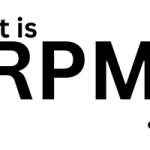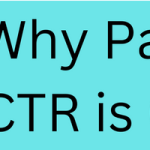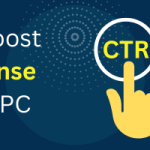What is page CTR? (Google AdSense)
In AdSense, CTR stands for Click-Through Rate. It’s a metric used to measure the effectiveness of an advertising campaign or individual ads. CTR is calculated by dividing the number of clicks an ad receives by the number of times it’s shown (impressions), then multiplying by 100 to get a percentage.
Here’s the formula:
CTR=(Number of ClicksNumber of Impressions)×100CTR=(Number of ImpressionsNumber of Clicks)×100
For example, if an ad receives 100 clicks from 10,000 impressions, the CTR would be:
CTR=(10010,000)×100=1%CTR=(10,000100)×100=1%
A higher CTR typically indicates that an ad is relevant and engaging to the audience, while a lower CTR might suggest that the ad needs adjustment or that it’s not resonating well with the viewers.
As of my last update, Google AdSense doesn’t disclose its average click-through rate (CTR) publicly, as it can vary widely depending on factors like the ad’s placement, content relevance, audience demographics, and industry. However, typical CTRs for AdSense ads can range from as low as 0.5% to 5% or even higher in some cases. It’s important to note that these figures are just rough estimates and may not be reflective of every situation. Ultimately, your CTR will depend on numerous factors specific to your website and its audience.
How much AdSense CTR is safe?
There isn’t a specific “safe” or “unsafe” CTR threshold for AdSense because it can vary greatly depending on factors like your website’s niche, the quality of your content, the placement and design of your ads, and the behavior of your audience.
However, it’s essential to adhere to Google’s AdSense program policies, which prohibit any form of artificial manipulation of ad clicks, including click fraud. Engaging in click fraud or attempting to artificially inflate your CTR can result in penalties, including suspension or termination of your AdSense account.
As a general guideline, aim to maintain a CTR that reflects genuine user engagement and interest in your content and ads. Avoid tactics that might artificially inflate your CTR, and focus on creating high-quality content and providing a positive user experience on your website. If you have concerns about your CTR or AdSense performance, you can always refer to Google’s guidelines or reach out to their support team for assistance.
What is a good CTR on Google Ads?
A “good” click-through rate (CTR) on Google Ads can vary widely depending on factors such as the industry, advertising goals, targeting, and ad format. However, as a general benchmark, a CTR above the average for your industry and ad type is typically considered good.
Across industries, average CTRs on Google Ads often fall between 1% and 5%. However, this can vary significantly. For highly competitive industries or broad targeting, CTRs may be lower, while niche markets or highly targeted campaigns may achieve higher CTRs.
It’s essential to consider your specific context when evaluating your CTR. Factors such as the quality of your ad copy, the relevance of your keywords, the effectiveness of your targeting, and the user experience on your landing page all influence CTR.
Ultimately, focus on improving your CTR over time by optimizing your ads, refining your targeting, and enhancing the user experience to encourage more clicks from interested users. Additionally, compare your CTR to industry benchmarks and monitor it regularly to gauge your performance and identify areas for improvement.
Here are some ideas to help improve your Google Ads click-through rate (CTR):
- Keyword Optimization: Ensure your ads are targeting relevant keywords that match user intent. Conduct keyword research to identify high-performing keywords with lower competition and higher relevance to your offerings.
- Compelling Ad Copy: Write compelling ad copy that grabs attention, highlights unique selling points, and includes a clear call-to-action (CTA). Use persuasive language and ad extensions like sitelinks, callouts, and structured snippets to enhance your ads.
- Ad Extensions: Take advantage of ad extensions to provide additional information and increase ad visibility. Extensions like call extensions, location extensions, and review extensions can improve CTR by offering more value to users.
- Ad Testing: Conduct A/B testing to experiment with different ad variations, including headlines, descriptions, and CTAs. Test different messaging, offers, and formats to identify which combinations resonate best with your audience.
- Landing Page Optimization: Ensure your landing pages are optimized for the ad campaign’s objectives and provide a seamless user experience. Align the landing page content with the ad messaging, make it easy for users to find what they’re looking for, and optimize for mobile devices.
- Ad Placement: Experiment with different ad placements and formats to find the most effective positions for your ads. Test placements on Google Search, Display Network, YouTube, and other relevant channels to reach your target audience effectively.
- Negative Keywords: Use negative keywords to prevent your ads from showing for irrelevant search queries. By filtering out irrelevant traffic, you can improve CTR and increase the likelihood of attracting clicks from qualified leads.
- Quality Score Optimization: Improve your Quality Score by focusing on factors like ad relevance, expected click-through rate, and landing page experience. Higher Quality Scores can lead to better ad positions and lower costs per click (CPC), ultimately improving CTR.
- Targeting Refinement: Refine your targeting parameters based on demographic data, interests, behaviors, and remarketing lists to reach the most relevant audience segments. Tailor your ad messaging to resonate with each audience segment for higher engagement.
- Continuous Monitoring and Optimization: Regularly monitor your ad performance metrics, including CTR, and make data-driven optimizations to improve results over time. Stay informed about industry trends, competitor activities, and changes in user behavior to adapt your strategies accordingly.
By implementing these ideas and continuously refining your Google Ads campaigns, you can improve your click-through rate and drive more valuable traffic to your website.
How do I get high CTR on Adsense?
To achieve a high click-through rate (CTR) on AdSense, you can employ various strategies to optimize your ad placement, design, and targeting. Here are some effective tactics:
- Strategic Ad Placement: Experiment with different ad placements on your website to find the most effective positions. Generally, placing ads above the fold, near content, and within the natural eye flow of your visitors can lead to higher CTR.
- Responsive Ad Units: Use responsive ad units that adapt to various screen sizes and devices. This ensures that your ads are displayed optimally across desktops, tablets, and smartphones, maximizing visibility and engagement.
- Ad Formats and Sizes: Test different ad formats and sizes to see which ones perform best with your audience. AdSense offers various formats, including display ads, link units, and native ads. Consider using larger ad sizes for higher visibility and potentially better performance.
- Blend or Contrast Ads: Experiment with blending ad colors and styles with your website’s design for a seamless user experience, or contrast them to make them stand out. Find a balance that attracts attention without being intrusive.
- High-Quality Content: Create valuable and engaging content that attracts and retains visitors to your website. Relevant content increases the likelihood of users clicking on ads related to their interests.
- Optimize for Mobile: Ensure that your website and ads are mobile-friendly, as an increasing number of users browse the internet on mobile devices. Responsive design and mobile-optimized ads can improve user experience and CTR.
- Avoid Ad Clutter: Don’t overcrowd your website with too many ads, as it can overwhelm visitors and lead to ad blindness. Focus on quality over quantity and strategically place ads where they’ll be most effective.
- Experiment with Ad Types: Test different ad types, including text, display, and native ads, to see which ones resonate best with your audience. Some websites may perform better with text-based ads, while others may benefit more from visual display ads.
- Optimize Page Speed: Improve your website’s loading speed to enhance user experience and reduce bounce rates. Faster-loading pages can increase the likelihood of users staying on your site and interacting with ads.
- Regular Performance Analysis: Monitor your AdSense performance regularly to identify trends, understand what works best for your audience, and make data-driven optimizations to improve CTR over time.
Remember to adhere to AdSense program policies and guidelines to maintain a healthy and sustainable ad revenue stream. By implementing these strategies and continually refining your approach, you can increase your AdSense CTR and maximize your earnings potential.
Is 20% CTR good?
A 20% click-through rate (CTR) on AdSense would be exceptionally high and would likely raise some eyebrows. While it’s not impossible to achieve such a high CTR, especially for specific ad formats or in certain circumstances, it’s relatively uncommon and could potentially raise concerns about invalid activity or click fraud.
Google closely monitors CTR and other metrics to detect any suspicious activity that may violate its policies. An unusually high CTR could trigger an investigation into your account, and if Google determines that the clicks are not genuine or are the result of click fraud, it could lead to penalties such as account suspension or termination.
It’s essential to focus on maintaining a healthy and sustainable CTR that reflects genuine user engagement with your content and ads. While it’s natural to strive for higher CTRs, excessively high rates could indicate issues with your ad implementation, targeting, or user experience.
If you’re seeing a CTR significantly higher than 20%, it’s a good idea to review your ad placement, targeting strategies, and website user experience to ensure that your ads are being displayed to the right audience and that users are engaging with them authentically.
How much CTR is good for SEO?
Click-through rate (CTR) is not a direct ranking factor for search engine optimization (SEO) in the traditional sense. Google has stated that they don’t use CTR as a direct ranking factor in their algorithms. However, CTR indirectly affects SEO in several ways:
- Organic Search CTR: The CTR of your organic search listings in search engine results pages (SERPs) can impact your SEO indirectly. Higher CTRs indicate that users find your listings relevant and compelling, which can lead to increased traffic and potentially higher rankings over time. Google aims to deliver the most relevant and useful results to users, so if your listings consistently attract clicks, it can signal to Google that your content is valuable and deserves higher visibility.
- User Engagement Signals: User engagement signals, including CTR, dwell time (the amount of time users spend on your website), and bounce rate, provide insights into the quality and relevance of your content. While Google doesn’t use CTR as a direct ranking factor, it does use user engagement signals to assess the quality of your content and its relevance to search queries. Higher CTRs combined with other positive engagement metrics can contribute to improved SEO performance.
- SERP Features and Rich Snippets: Optimizing your organic listings to stand out in SERPs can increase your CTR. Features like rich snippets, meta descriptions, and compelling titles can make your listings more attractive to users, potentially leading to higher CTRs. While these optimizations may not directly influence rankings, they can enhance visibility and click-through rates, which can indirectly impact SEO.
- Brand Authority and Trust: Higher CTRs can contribute to building brand authority and trust over time. When users consistently click on your listings in search results, it signals to Google that your website is a credible source of information. As a result, Google may be more likely to rank your site higher for relevant queries, leading to improved SEO performance.
While there’s no specific threshold for what constitutes a “good” CTR for SEO, aim to optimize your organic listings to attract clicks and provide value to users. Focus on creating compelling titles and meta descriptions, optimizing for relevant keywords, and delivering high-quality content that meets the needs of your target audience. By focusing on user engagement and relevance, you can improve your SEO performance over time.
How to calculate CTR?
To calculate the Click-Through Rate (CTR), you divide the number of clicks an ad or link receives by the number of times it was shown (impressions), then multiply by 100 to express it as a percentage. Here’s the formula:
CTR=(Number of ClicksNumber of Impressions)×100CTR=(Number of ImpressionsNumber of Clicks)×100
For example, if your ad received 100 clicks from 10,000 impressions, the CTR would be calculated as follows:
CTR=(10010,000)×100CTR=(10,000100)×100
CTR=(0.01)×100CTR=(0.01)×100
CTR=1%CTR=1%
So, in this example, the Click-Through Rate (CTR) is 1%. This means that for every 100 times the ad was shown (impressions), it received one click.
Why is my CTR so low?
A low click-through rate (CTR) can be influenced by various factors, and diagnosing the exact cause requires analyzing several aspects of your advertising campaign or website. Here are some common reasons why your CTR might be low:
- Relevance: Your ads may not be relevant to your target audience or the content of your website. Ensure that your ads are closely aligned with the interests and needs of your audience and that they match the content contextually.
- Ad Positioning: The placement of your ads on your website or within search engine results pages (SERPs) may not be optimal. Experiment with different ad placements to identify positions that attract more attention and clicks.
- Ad Creatives: The design, messaging, and call-to-action (CTA) of your ads may not be compelling enough to entice users to click. Consider testing different ad creatives, including variations in headlines, descriptions, and imagery, to identify what resonates best with your audience.
- Targeting: Your ads may not be reaching the right audience. Review your targeting settings, including demographics, interests, keywords, and geographic location, to ensure that you’re reaching users who are most likely to be interested in your offerings.
- Ad Fatigue: Users may become accustomed to seeing your ads and start ignoring them over time. Refresh your ad creatives periodically to prevent ad fatigue and maintain user engagement.
- Ad Blocking: Some users may be using ad-blocking software, which prevents your ads from being displayed to them. While you can’t control this directly, focusing on providing value to users through non-ad content can help retain engagement.
- Competition: Your industry or niche may be highly competitive, making it challenging to stand out and attract clicks. Monitor your competitors’ strategies and consider what sets your offerings apart to differentiate yourself effectively.
- Website Experience: Poor website design, navigation, or user experience may discourage users from clicking on your ads. Ensure that your website is user-friendly, fast-loading, and mobile-responsive to improve engagement and encourage clicks.
- Keyword Quality: If you’re running search ads, the keywords you’re targeting may not be highly relevant or may have low search volume. Review your keyword selection and refine your targeting to focus on more relevant and high-intent keywords.
- Seasonality: Your industry or business may experience fluctuations in demand or user behavior based on seasonality or other external factors. Adjust your ad strategy accordingly to capitalize on peak periods and mitigate lower performance during off-peak times.
By analyzing these factors and making strategic adjustments to your advertising campaign or website, you can work towards improving your CTR over time. Testing, monitoring performance metrics, and iterating on your approach based on insights gained will help you optimize for better results.
In conclusion, understanding and improving your click-through rate (CTR) is crucial for maximizing the effectiveness of your advertising efforts. A low CTR can indicate issues with relevance, targeting, ad creatives, or website experience, among other factors. By diagnosing the reasons behind your low CTR and implementing strategic optimizations, you can attract more clicks, increase user engagement, and ultimately drive better results for your business.
Additionally, it’s essential to consider your revenue per thousand impressions (RPM), which measures the earnings generated per thousand ad impressions. Improving your CTR can positively impact your RPM by increasing ad clicks and revenue potential. By focusing on both CTR and RPM, you can optimize your ad monetization strategy for maximum profitability.
For more insights on optimizing your CTR, RPM, and overall ad performance, I encourage you to visit our blog post What is RPM for further reading. Discover practical tips, best practices, and strategies to enhance your advertising effectiveness and achieve your business goals.



